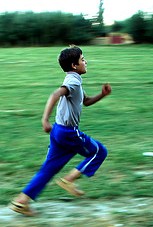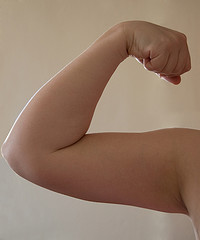
Your body is an amazing machine, certainly more remarkable than any machine devised by humans. It can run, jump, throw a baseball, or perform delicate movements, such as threading a needle. Body movement is possible because many parts of your body work together. All of these parts are made up of cells, such as nerve cells, bone cells, brain cells, blood cells, and muscle cells.
Cells come in many different shapes and sizes depending on what their function is. You might think that all muscles cells would be alike, but no so. Like other kinds of cells, muscles come in all shapes and sizes, depending on their location and function.
Photos from search.creativecommons.com
Your body has about 600 muscles, which make up about 40% of your body weight. Bones provide the skeletal framework to which muscles are attached, but it is the muscles that move the bones and create movement. Of course it is brain cells that send the orders for muscles to move and this message is send via nerve cells.

When muscles work, they contract; that is, they get shorter and thicker. Muscles can only pull, they cannot push. This is why many skeletal muscles, like those in your upper arm, work in pairs. One muscle, called a flexor, works by pulling on a tendon to bend a joint (where bones meet) while the other muscles relaxes. When the flexor muscle relaxes, the other muscle, called an extensor, pulls on a different tendon to straighten the same join. Almost every body movement requires the use of both flexor and extensor muscles.
DISCOVER FOR YOURSELF
Pushing up on the underside of a heavy table causes the flexor muscle in the front of your arm to contract and harden. Ask someone to sit next to a heavy table and with his or her hand, palm side up, try to lift the table with medium pressure. Caution your helper not to strain. While pressure is being applied to the table, feel the front and back of your helper’s upper arm. The front of the arm feels harder than the back of the arm. This is because the front muscle is contracting and the back muscle is relaxing.
Next, ask your helper to place his or her hand, palm down, on top of the table and to press down. Again, feel the same parts of your helpers upper arm. This time, the back of the arm feels harder than the front of the arm. The back muscle feels harder than the front muscle. This is because the front muscle is relaxing while the back muscle is contraction.
More Later, Janice
You can find more fun challenging science activities about muscles and bones in these Janice VanCleave books:

